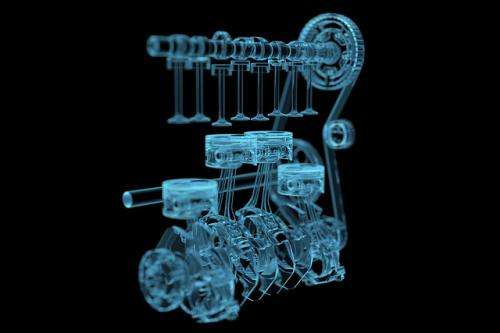Researchers create successful predictions of combustion reaction rates

Researchers at the U.S. Department of Energy's Argonne and Sandia National Laboratories have demonstrated, for the first time, a method to successfully predict pressure-dependent chemical reaction rates, an important breakthrough in combustion and atmospheric chemistry that is expected to benefit auto and engine manufacturers, oil and gas utilities and other industries that employ combustion models.
For years, combustion scientists have worked to better understand the thousands of chemical reactions that take place during the combustion process, said Sandia's Ahren Jasper, the study's lead author.
As they determine and understand the speeds and outcomes of more and more of these reactions, Jasper said, researchers can use models to more fully characterize what's occurring inside an engine, and thus better predict combustion efficiency and the emissions formed during combustion.
A more detailed, fundamental understanding of the chemistry of combustion, in turn, may lead to cleaner and more efficient strategies in automotive vehicle and fuel design.
Argonne chemist Stephen Klippenstein, another author of the study, said this method should aid development of global models for all gas phase chemical environments, including the Earth's atmosphere. Better models, in turn, will improve understanding of climate change and boost efforts to address it.
Many of the key steps underlying gas-phase combustion involve elementary chemical reactions that are strongly pressure-dependent, and researchers who develop combustion models require detailed descriptions of these reactions.
But, while significant progress has been made over the years in understanding combustion chemistry, the outcome and rates of pressure-dependent chemical reactions – those that depend on the pressure of the gas in the engine – have been very difficult to predict. These reactions depend on the pressure because when the reacting molecules collide with other gas molecules, the energy and angular momentum of the molecules is redistributed, which changes the speed and outcome of the reactions.
Previous qualitative research focused on how various molecular properties influence energy transfer rates, but no accurate method could make a priori predictions of the rate constants, that is, predictions based on theoretical deduction, not observation.
"We've desperately needed the ability to compute and calculate precisely how chemical reactions depend on temperature and pressure, and now we have that," said Jasper.
The team focused on modeling the collisions of molecules in atomistic detail and characterizing the transfer of energy and angular momentum that takes place as a result of those collisions.
"We succeeded by using more accurate models for describing the interaction of the colliding species and by focusing on only those aspects of energy transfer that are most relevant in determining the reaction rate," Jasper said. This allowed the researchers to develop a detailed description of collision outcomes.
Jasper and his colleagues then were able to obtain that collision outcome information using direct "classical trajectories" that explicitly describe the motion of the atoms in the molecules and to use this information in calculating chemical reaction rates.
A key step, Jasper said, was the development of a model for the collisional energy and angular momentum transfer function that reproduced detailed features predicted by the trajectories and was simple enough to be used in practical reaction rate calculations.
"Finding a way to accurately compute and represent the energy and angular momentum transfer from these vibrationally-excited molecules proved to be the final piece needed to solve the problem," said Jasper.
"The overall theoretical model is rather complex, involving many separate unrelated calculations, and it is remarkable how accurately one can now treat all aspects of the problem in developing such completely a priori predictions," Klippenstein said.
The study was also co-authored by Klippenstein and Larry Harding, both Distinguished Fellows at Argonne, and the influential combustion modeler Jim Miller, a former Sandia staff member now at Argonne. The work continues the team's longstanding development of master equation and elementary reaction rate theories.
"This effort was a true collaboration with both labs playing key roles in the intellectual foundations of the work as well as in the actual computations," Klippenstein noted. "The combined expertise in energy transfer calculations and in reaction rate theories was central to the success of the project."
"A close but loose-knit working group was developed with these combustion modeling experts over the years, and we've developed excellent professional relationships that have led to this technical achievement," Miller added.
More information: "Predictive a priori pressure-dependent kinetics." Science 5 December 2014: Vol. 346 no. 6214 pp. 1212-1215. DOI: 10.1126/science.1260856
Journal information: Science
Provided by Argonne National Laboratory


















